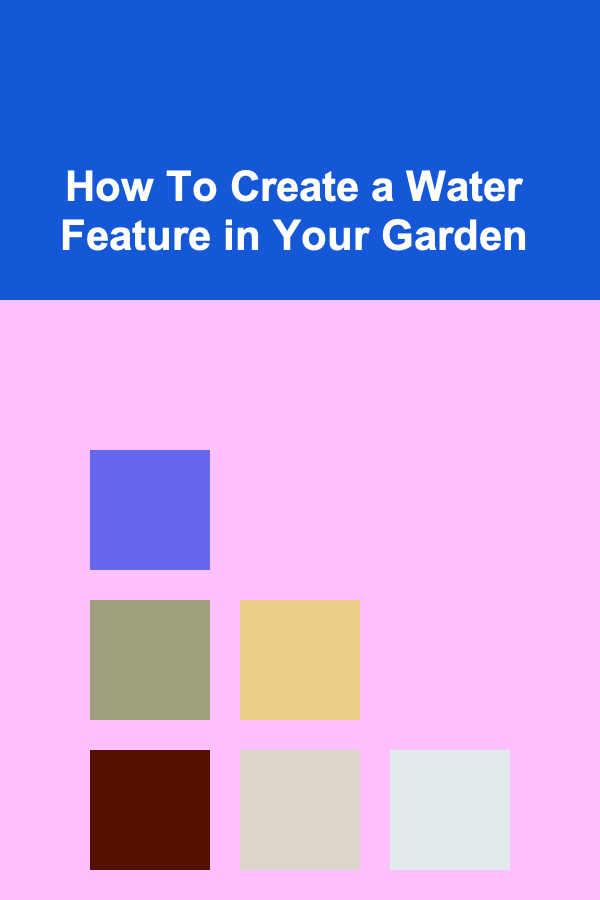
How To Create a Water Feature in Your Garden
ebook include PDF & Audio bundle (Micro Guide)
$12.99$5.99
Limited Time Offer! Order within the next:

Creating a water feature in your garden can transform an ordinary outdoor space into a tranquil and visually striking environment. The soothing sound of flowing water, the beauty of reflective surfaces, and the potential to host a variety of plants and wildlife make water features a popular choice for homeowners looking to enhance their garden's appeal. Whether you have a large backyard or a small patio, there's a water feature design to suit any space and style.
This article will guide you through the process of designing and building a water feature in your garden, exploring the types of water features, the essential materials, the steps involved, and tips for maintaining your installation.
The Appeal of Water Features
Before diving into the how-to, it's important to understand why water features are so beloved in garden design. Here are a few reasons why you might consider incorporating one into your landscape:
- Aesthetic Appeal: Water features serve as eye-catching focal points that complement your garden's aesthetics. Whether you opt for a small pond, a cascading waterfall, or a modern water wall, the addition of water creates a sense of tranquility and beauty.
- Sound of Water: The sound of flowing or trickling water is known to have a calming effect. It masks background noise, creating a peaceful and serene atmosphere, especially in urban or noisy environments.
- Wildlife Habitat: A well-designed water feature can attract birds, frogs, and other small wildlife to your garden. Water is essential for many species, and your feature could become an oasis for local creatures.
- Improved Microclimate: Water features help with cooling the surrounding air, especially during hot summer months. The evaporation process can lower the temperature in your garden, making it more comfortable.
- Aesthetic Versatility: Water features can be incorporated into various garden styles, from traditional and rustic to modern and minimalist. There's no one-size-fits-all; it's about choosing what best fits your garden's personality.
Types of Water Features
Before building a water feature, you must decide what kind of feature you want. There are various types of water features, each with its own distinct aesthetic and purpose:
2.1. Ponds
Ponds are one of the most popular water features for gardens, providing a versatile backdrop for plants, fish, and other wildlife.
- Design Options: Ponds can vary in size and shape. You can create a natural-looking pond that blends into your garden or a formal, symmetrical pond with clean lines and edges.
- Depth Considerations: When designing a pond, it's important to consider the depth. A depth of 18 inches is sufficient for most plants and fish, but deeper ponds may be necessary for larger fish like koi.
- Filtration: To keep the water clean, you may need a filtration system, especially if you plan to add fish.
2.2. Waterfalls
Waterfalls add movement and sound to your garden, creating a dynamic visual effect as water cascades down rocks or other structures.
- Installation: Waterfalls can be as simple or complex as you wish. Some people opt for small, tabletop waterfalls, while others create larger, multi-tiered falls that spill into a pond or stream.
- Water Flow: The sound of flowing water is one of the main appeals of a waterfall, so you should aim for a gentle flow if you're looking for relaxation. A loud, rushing waterfall may be suitable for more dramatic, larger spaces.
2.3. Fountains
Fountains come in a wide variety of designs, from classic, tiered structures to more modern, minimalist forms.
- Design Variety: Fountains are incredibly versatile and can fit almost any garden style. You can opt for a traditional stone fountain, a contemporary water bowl, or even a wall-mounted fountain.
- Sound Effects: Like waterfalls, fountains add the pleasant sound of flowing water to your garden, though the sound tends to be more contained and less dramatic than a waterfall.
2.4. Streams
Streams are a perfect addition for larger gardens, especially if you want to create a more natural, meandering water feature.
- Design and Flow: A stream allows water to flow through the landscape, often ending in a pond or waterfall. The meandering nature of a stream can create a sense of journey, guiding the eye through different areas of the garden.
- Pumps: Streams require pumps to keep the water flowing, and they may need additional filtration to prevent debris build-up.
2.5. Birdbaths
If you have a small garden or even a balcony, a birdbath can provide a simple yet effective water feature that invites local wildlife.
- Attraction for Wildlife: Birds will come to bathe and drink, bringing movement and life to your garden.
- Easy Installation: Birdbaths are easy to set up, often consisting of a simple basin on a pedestal. They don't require complex systems or a large area.
Materials You'll Need
Creating a water feature requires a variety of materials, depending on the type of feature you choose. Here are the basic materials you'll need for a pond, waterfall, or fountain:
- Liner: A pond liner is essential for keeping the water contained and preventing it from leaking into the ground. You can choose between rubber or PVC liners, which are both durable and flexible.
- Pump: For moving water in features like waterfalls, streams, and fountains, a pump is necessary to circulate the water. Be sure to select the appropriate size pump for your feature to ensure proper flow.
- Filtration System: A filter helps keep the water clean and clear, preventing algae growth and debris build-up. For ponds and waterfalls, a pump and filter combination is ideal.
- Rocks and Stones: These add texture and beauty to your water feature. Natural stones work well for pond edges, waterfalls, and streams, creating a more natural appearance.
- Waterproof Adhesive: You may need waterproof sealant or adhesive to secure rocks or create a barrier between the water and certain surfaces.
- Plants and Decorations: Water lilies, lotus flowers, and aquatic grasses can be added to ponds for aesthetic value. Floating plants and submerged plants also help oxygenate the water and provide shelter for fish.
- Fish and Wildlife: If your pond is large enough, you might want to consider adding fish such as koi or goldfish. Ensure your pond is large and deep enough to support them.
Step-by-Step Guide to Building a Water Feature
Now that you've decided on the type of water feature and gathered the materials, it's time to start building. Follow this step-by-step guide for a simple yet effective water feature.
Step 1: Plan Your Design
Before you start digging or purchasing materials, carefully plan out the design. Consider the following:
- Location: Choose a spot that gets enough sunlight but also provides some shade for fish and plants. Too much sun can lead to algae growth.
- Size: Decide on the size of your water feature based on the available space in your garden. Remember that larger features require more maintenance.
- Style: Choose a design that complements your garden style. Will it be a tranquil, reflective pond, or a dramatic, bold waterfall?
Step 2: Dig the Hole
Once your design is planned, begin digging the hole for your pond or water feature. Ensure the depth is appropriate for your chosen plants and wildlife. It's a good idea to create a gently sloping edge, especially for ponds, so that fish can swim comfortably.
- For Ponds: The pond should have a shallow shelf around the edges for plants, and deeper areas for fish.
- For Waterfalls/Streams: Dig channels or slopes for water to flow through. Ensure there's enough depth to house the pump and filter.
Step 3: Install the Liner
Lay the pond liner in the hole, ensuring it covers all surfaces. Use rocks or bricks to secure the edges of the liner, and smooth out any wrinkles.
- For a stream, the liner should be spread out to direct the flow of water.
- For a waterfall, you may need multiple layers to guide the water's flow.
Step 4: Add the Pump and Filter
Place your pump in the deepest section of the pond or stream. Make sure the pump is positioned correctly to achieve the desired water flow. The filter should be placed in an accessible location for easy maintenance.
- If you're adding a fountain, position the pump centrally to create an even flow of water.
Step 5: Add Rocks and Stones
Carefully place rocks around the edges of the pond and waterfall. Use larger stones to stabilize the liner and smaller rocks to hide the edges and give the feature a natural look.
Step 6: Install Plants and Wildlife
Introduce aquatic plants to your pond or water feature. Floating plants like water lilies and submerged plants such as hornwort are perfect for ponds. If your feature can accommodate fish, add them once the water is balanced.
- For fountains: Place smaller decorative plants around the feature for added beauty.
Step 7: Fill the Feature with Water
Slowly fill the feature with water, ensuring the liner remains intact. Allow the water to settle before turning on the pump.
Step 8: Test the System
Switch on the pump and observe the water's flow. Adjust the pump's flow rate if necessary and ensure that the water feature works as intended.
Maintenance Tips
Regular maintenance is key to keeping your water feature looking beautiful and functioning properly.
- Clean the Pump: Ensure the pump is clear of debris and algae build-up. Clean it every few months to ensure smooth operation.
- Monitor Water Quality: Check the water quality regularly. If you have fish, maintain a proper balance of pH and oxygen levels.
- Trim Plants: Remove dead leaves and overgrown plants to prevent clogging the filter or pump.
- Algae Control: Use natural methods like barley straw or UV sterilizers to control algae growth.
Conclusion
Creating a water feature in your garden is a rewarding project that can significantly enhance your outdoor space. From calming ponds and dynamic waterfalls to minimalist fountains, water features offer endless possibilities for design. With careful planning, the right materials, and regular maintenance, you can enjoy the beauty and tranquility that a water feature brings to your garden for years to come.

How to Set Up Regular Check-ins with Your Team
Read More
How to Start a Painting or Photography Service for Clients: An Actionable Guide
Read More
Why Organizing Your Travel Essentials Reduces Stress
Read More
How to Study Coral Reef Ecosystems
Read More
Mastering Video Transcoding: A Comprehensive Guide
Read More
How to Design Vintage-Style Posters in Illustrator
Read MoreOther Products

How to Set Up Regular Check-ins with Your Team
Read More
How to Start a Painting or Photography Service for Clients: An Actionable Guide
Read More
Why Organizing Your Travel Essentials Reduces Stress
Read More
How to Study Coral Reef Ecosystems
Read More
Mastering Video Transcoding: A Comprehensive Guide
Read More